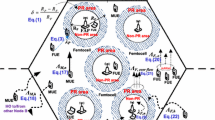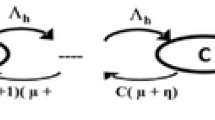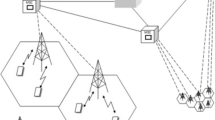Abstract
The major focus of this paper is the design and control of micro/picocellular wireless access systems supporting non‐real‐time (or data) traffic subject to a guaranteed quality‐of‐service as defined by four metrics: call blocking probability, cell overload probability, average wireless bandwidth available to a mobile terminal, and probability that the available wireless bandwidth per mobile is less than some specified threshold. We utilize a cell‐cluster based call admission control concept and provide a model as well as an analytical methodology which can be used to design wireless micro‐cellular networks (as specified by the number of base stations required to serve the traffic generated within a given geographical area), and to control new call admission such that once a call is admitted to the system, it will enjoy a predefined quality‐of‐service without requiring intervention of the network call processor independent of how large the Erlang load offered to the network may become. This is an important property for wireless access networks: although the network may be traffic engineered to provide an acceptable call blocking probability under anticipated Erlang load, user mobility may occasionally cause that load to exceed design thresholds, and yet the QOS offered to already admitted calls must be maintained.
Similar content being viewed by others
References
A.S. Acampora and M. Naghshineh, An architecture and methodology for mobile-executed cell hand-off in wireless ATM networks, IEEE Journal on Selected Areas in Communications 12(8), Special Issue on Wireless and Mobile High-Speed Communications (October 1994).
A.S. Acampora and M. Naghshineh, Control and quality-of-service provisioning in high-speed microcellular networks, IEEE Personal Communications Magazine (Second Quarter 1994).
A.S. Acampora and J.H. Winters, A wireless network for wide-band indoor communications, IEEE Journal on Selected Areas in Communications 5 (June 1987).
S.T.S. Chia, Mixed cell architecture and handover, IEE Colloquium on 'Mobile communications in the year 2000', No. 139, UK (June 1992).
L.J. Cimini Jr, G.J. Foschini and C.-L. I, Distributed dynamic channel allocation for microcellular networks.
D. Cox, Wireless personal communications: What is it?, IEEE Personal Communications (April 1995).
D. Goodman, Future directions for wireless data, in: Digest of Papers, Spring COMPCON (1994).
L.I. Greenstein et al., Microcells in personal communication systems, IEEE Communications Magazine (December 1992).
R. Guerin, Queueing-blocking systems with two arrival streams and guard channels, IEEE Transactions on Communications 36 (February 1988).
J. Ioannidis, D. Duchamp and G. Maguire, IP-based protocols for mobile internetworking, in: Proc. ACM SIGCOMM (1991).
F.P. Kelly, Reversibility and Stochastic Networks (Wiley, New York, 1979).
G. Kenward, Mobile data communications: the future is in the networks, in: Proceedings of IEEE International Conference on Selected Topics in Wireless Communications (1992).
W.C.Y. Lee, Smaller cells for greater performance, IEEE Communications Magazine (November 1991).
M. Naghshineh and A.S. Acampora, QOS provisioning in microcellular networks supporting multiple classes of traffic, Wireless Networks 2, Special Issue on Wireless Multimedia Networking (1996).
S.-H. Oh and D.-W. Tcha, Prioritized channel assignment in a cellular radio network, IEEE Transactions on Communications 40(7) (July 1992).
C. Perkins, Providing continuous network access to mobile hosts using TCP/IP, Computer Networks and ISDN Systems (November 1993).
C. Purzynski and S. Rappaport, Traffic performance analysis for cellular communication systems with mixed platform types and queued hand-offs, Technical Report 653, College of Engineering and Applied Sciences, SUNY, New York.
J. Sarnecki et al., Microcell design principles, IEEE Communications Magazine (April 1993).
M. Schwartz, Telecommunication Networks: Protocols, Modeling and Analysis (Addison-Wesley Reading, MA, 1987).
R. Steele, The evolution of personal communications, IEEE Personal Communications Magazine 1(2) (Second Quarter 1994).
S. Tekinay and B. Jabbari, Handover and channel channel assignment in mobile cellular networks, IEEE Communications Magazine 29(11) (November 1991).
F. Teraoka and M. Tokoro, Host migration transparency in IP networks, Comp. Commun. Rev. (January 1993).
W. Webb, J. Williams and R. Steele, Microcellular teletraffic levels, in: Proceedings of 7th IEE European Conference on Mobile and Personal Communications (1993).
J.H. Winters, Optimum combining for indoor radio systems with multiple users, IEEE Transactions on Communications 11 (November 1987).
J. Zander, Performance of optimum transmitter power control in cellular radio systems, IEEE Transactions on Vehicular Technology 41(1) (February 1992).
Author information
Authors and Affiliations
Rights and permissions
About this article
Cite this article
Naghshineh, M., Acampora, A.S. Design and control of micro‐cellular networks with QOS provisioning for data traffic. Wireless Networks 3, 1–8 (1997). https://doi.org/10.1023/A:1019113502663
Issue Date:
DOI: https://doi.org/10.1023/A:1019113502663




